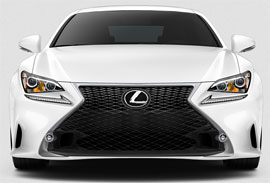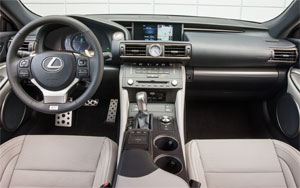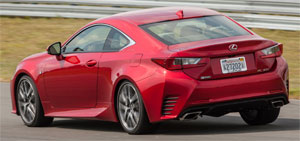2015 Lexus RC Sport Coupe
If you’ve been following the Lexus brand lately, you know that they’re on an all-out mission to shed their soft, comfy, pure luxury image…that’s still a work in progress; it takes a long time to change people’s minds about a brand. But the new RC coupe just might be the car that speeds that change along.
The 2015 Lexus RC marks the brand’s reentry into the sporty coupe segment. And from the looks of this car, they’re not jumping back in quietly. The RC may not instantly strike fear into the hearts of the German marques that dominate this segment, but they will certainly know Lexus has joined the party.
The RC’s compliant, yet very rigid chassis is an all-star for sure. It’s not a new chassis per se, but a modified combination of 2 separate Lexus platforms. The front architecture and suspension comes from the mid-size GS, while the rear comes from the compact IS, with a lot of structural bracing in between. Enough to satisfy a fairly wide variety of tastes.
Taking a walk through the lineup, things start with the RC 350. It’s the tamest model with a 3.5-liter V6 coming directly over from the GS, outputting the same 306-horsepwer and 277 lb-ft. of torque. Transmission is also the same 8-speed automatic, with steering wheel shifters, unless you choose all-wheel-drive in which case you’ll lose 2 gears.
 But, the outside is anything but tame. While it may not the most dynamic looking Lexus of all-time, it’s pretty darn close.
But, the outside is anything but tame. While it may not the most dynamic looking Lexus of all-time, it’s pretty darn close.
It’s still Lexus-smooth, but with plenty of sharp angles and body tucks to drum up some excitement. The front end screams aggression with a big-mouth grille and vertical openings slashed into the corners.
18-inch wheels are standard, with significant fender flares above them. L-shaped LED rear lighting has been updated with clear, jagged lenses protruding out. The rear bumper also gets slashed up with simulated corner vents.
Inside, things are less of a departure. There’s still lots of luxury to touch and plenty of serenity to be had when driving. Lexus calls this a pure 2+2 Coupe, so rear space, especially leg room, is limited.
4-dial gauges set a sporty tone, with a small central TFT screen providing plenty of info. 10.4 cubic-ft of space hides in the trunk, and useful folding rear seatbacks add to that. Neither back-up camera nor navigation are standard, however, but if you do upgrade, there’s a new remote touchpad for inputs.
Next up the line is the RC 350 F Sport, and the added content is very high. For the exterior, there are 19-inch wheels, unique front and rear fascia, and fender badging.
Inside it gets even better with supportive sport seats, new sport pedals, LFA-inspired gauges, black headliner, and tasteful silver trim.
 While the Sport’s engine is unchanged, there are lots of mechanical upgrades. Like adaptive variable suspension, high-friction brake pads, 4-wheel steering, and the additional Sport+ driving mode.
While the Sport’s engine is unchanged, there are lots of mechanical upgrades. Like adaptive variable suspension, high-friction brake pads, 4-wheel steering, and the additional Sport+ driving mode.
We spent most of our drive time in the F Sport and were very impressed with its light and balanced feel. Around the track at the Monticello Motor Club, things felt super-rigid with virtually no flex.
The rear-steer speeds up turn-ins, and the car has an almost Porsche-like competency, where you have a hard time believing you’re having this much fun in a straight-up street car, let alone a Lexus. And you can do some serious pushing without feeling like you’re going to end up in some “epic fail” video on You Tube.
But, where this tale really gets interesting is in the top-of-the-line RC F. This car is serious, with a 467-horsepwer 5.0-liter V8, as well as fully upgraded chassis and brakes.
It’s a beast! On the street, it feels a little nose heavy, and steering is slower, though you can dial in more with Sport and Sport+ settings, but we found it almost too aggressive for everyday use.
On the track however, it comes alive with the V8 growling on acceleration, and barking on downshifts. Transmission is also an 8-speed, but it’s different enough to get a separate internal name.
 A Torsen limited-slip rear is standard and you can upgrade to a torque vectoring rear, which includes “set-it-and-forget-it” presets for standard, slalom, and track. The torque vectoring rear is highly recommended, as it allows you to seriously late brake and perform dare-devil late turn-ins well beyond your skill set.
A Torsen limited-slip rear is standard and you can upgrade to a torque vectoring rear, which includes “set-it-and-forget-it” presets for standard, slalom, and track. The torque vectoring rear is highly recommended, as it allows you to seriously late brake and perform dare-devil late turn-ins well beyond your skill set.
All of that, along with huge 6-piston Brembos up front, make the RC F a legit player in the RS, M, and AMG game. Lexus claims 0-60 happens in 4.4-seconds and we believe it.
Prices are competitive too, starting at $43,715 for the RC 350, the F Sport comes in at $47,700, and the big-dog RC F goes for $63,325.
While the LFA got the performance-image ball rolling for Lexus, things have been slow in gaining momentum. But we think the 2015 RC is a game changer, and just what the Lexus makeover has been waiting for.
Specifications
- Engine: 3.5 liter V6
- Horsepower: 306
- Torque: 277 lb-ft.
2024 Polestar 2
More Range And More Power For The Polestar 2
Volvo is well on their way to making the transition to an all-electric brand, but their sister-brand Polestar is already there. Now, we’ve spent lots of time in their all-wheel drive, five-door Polestar 2, having tested it in 2021, and a year later when a two-wheel drive version arrived. But, EV updates are coming quickly. So, let us be your guide for all that’s new with the Polestar 2.
While we are driving more EVs than ever, we’ve also been spending a lot of time recently circling back to ones we’ve previously tested. As in this new era of electrified vehicles, significant updates are arriving quickly, with R&D investments increasing and retrofitting them easier than ever. This is often done through software updates that can even be accomplished over the air. For 2024, the Polestar 2 has indeed gotten some software updates, but some physical ones as well.
Clearly aimed directly at Tesla’s Model 3 when it arrived; the Polestar 2’s build quality was vastly better, but range definitely came up short. So, addressing that was priority No. 1; and for ’24 the Polestar can travel up to 20% farther than before while consuming 9% less energy, and when it comes time to charge it back up, it can do that 34% faster too.
Range in the Single Motor version increases from a max of 270 to 320 miles thanks to a larger 82-kWh battery pack, and that solitary motor now powers the rear wheels, not the front wheels. It’s also bigger, coming in at 220 kW compared to the previous 170 kW front-wheel drive version, going from 231 to 299 horsepower.
Dual Motors keep the same 78-kWh battery, but still sees a boost from 260 to 276 miles and takes advantage of the larger rear motor for a new combined 310-kW output with 421 horsepower. Our test car has the added Performance Pack, which uses an additional 35 kW to deliver 455 horsepower and 546 lb-ft of torque, though max range drops to just 247 miles.
The new battery in rear-drive 2s will also charge faster, now accepting up to 205 kW for an 80% charge in 20 minutes; max for dual-motors stays at 155 kW, which puts an 80% charge at 34 minutes. Using 32 kWh of electricity per 100 miles, the Dual Motor earns a good efficiency rating.
The [Polestar] 2 has always been one of the most enjoyable EVs to drive, even more so now with that additional power coming from the rear motor.
Unfortunately, extremely cold temperatures kept us from seeing that increased range, as we were only on pace for about 194 miles in our test.
The 2 has always been one of the most enjoyable EVs to drive, even more so now with that additional power coming from the rear motor. And especially when equipped with the Performance Pack as it not only includes more power, but adds 20-inch forged wheels, upgraded brakes, and adjustable Ohlins Dual Flow Valve performance dampers. It greatly improves handling prowess without affecting ride quality, and is easily worth the $5,500 charge if you at all enjoy driving.
Even on a 20-degree track day there was plenty of grip through our handling course. No understeer or oversteer, and lots of feedback through the wheel. There was a nice, strong launch off the line that properly planted us firmly in the seat, and rocketed us to 60 in 4.5 seconds. Power delivery stayed pretty intense up until about 80 mph when there was a definite tapering off. Still, it was a 13.4-second quarter-mile at 102 mph; smooth, quiet, and stable the whole way.
When this car debuted, its Google-based infotainment setup was a novelty, but since then, more and more manufacturers are just “Googling it” so it doesn’t seem out of place at all. The wireless phone charger is easy to access, and there’s a great Harmon/Kardon sound system and panoramic sunroof to enhance the in-cabin experience. Exteriors have also been enhanced with a smooth grille insert and new wheel choices.
Hatchback practicality means 14.3 cu-ft of easy to access cargo space with split-folding seatbacks for longer items and expanding the space to 38.7 cu-ft. Plus, there’s even a sizeable storage bin up front under the hood.
Single Motor Polestar 2 pricing now starts at $51,300, with Dual Motors starting at $56,700; topping out at $64,400.
For a car manufacturer that hasn’t even been around for a decade yet, Polestar has kept itself busy, totally transforming their latest model in just a few years, making the 2024 Polestar 2 even more appealing. They are certainly off to a good start, and with a host of Polestars just over the horizon, including some all-important utility vehicles, this star will be shining even brighter.
Specifications
As Tested
- Motor Setup: Dual Motor
- Horsepower: 455
- 0-60 mph: 4.5 seconds
- EPA Range: 247 miles
- Efficiency : 32 kWh / 100 miles
- Battery Size: 78-kWh
- Torque: 546 lb-ft
- 1/4 Mile: 13.4 seconds at 102 mph
- MW Test Loop: ~ 194 miles
- Peak Charging Rate: 155 kW











































